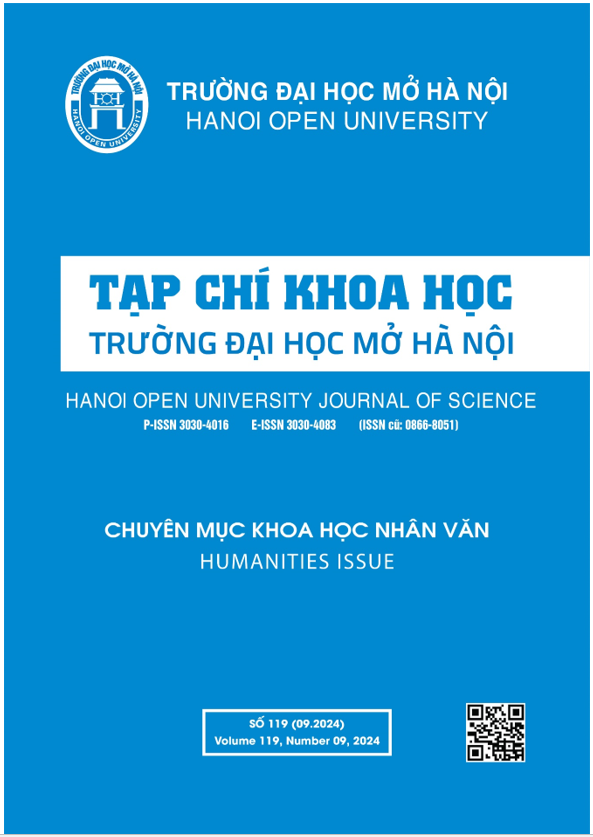DEVELOPING CRITICAL THINKING SKILLS TO TEACH WRITING SKILLS FOR THE THIRD- YEAR ENGLISH MAJORS AT HUNG YEN UNIVERSITY OF TECHNOLOGY AND EDUCATION
DOI:
https://doi.org/10.59266/houjs.2024.458Từ khóa:
critical thinking skills, writing skills, personal developments, thinking process, argumentative writingTóm tắt
It is logical to believe that a better thinker who has greater control over the thinking process is likely to get more benefits in his/her life. For students of language in general and of English language in particular, being able to think critically is crucial in developing language proficiency and communicative ability, which helps not only produce good argumentative writing but also join a debatable speech. Inspired by the above benefits, this study aims to assess students’ manifestation of critical thinking through 21 argumentative writings on both familiar and unfamiliar topics. The writings were carried out under time pressure during class hours by the third-year English majors of class 113213 at Hung Yen University of Technology and Education (UTEHY). By combining the model proposed by Stapleton (2001) and Ennis-Weir's set of criteria in the investigation quantitatively and qualitatively, the researcher could determine whether content familiarity plays a role in critical thinking. The results not only provide the answer to this inquiry but also show a certain grasp of critical thinking in the students' writings. According to this, students need more training in both writing and reasoning skills to avoid falling into inconsistency and a slippery slope; besides, students' familiarity with a certain topic significantly contributes to the quality of their arguments. Based on such results, some implications and suggestions for both learners and teachers are presented.
Tài liệu tham khảo
[1]. Baker, J. R., & Brizee, A. (2007). “The argumentative essay”. Retrieved January 12, 2009 from http://owl.english.purdue.edu/owl/ resource/685/05/
[2]. Dewey, J. (1933), How we think. Boston: D.C Health
[3]. Dowden, B.(2010, January). Fallacies. Internet Encyclopedia of Philosophy. Retrieved September 1, 2010, from http://www.iep.utm.edu/fallacy
[4]. Ennis, R., & Weir, E. (1985). Ennis- Weir’s critical thinking essay test. California: Midwest Publication. Retrieved May 17, 2010, from http:// faculty.ed.uiuc.edu/rhennis/tewctet/ Ennis-Weir_Merged.pdf
[5]. Ennis, R.H. (1985). A logical basis for measuring critical thinking skills, Educational Leadership, 43, 44-48.
[6]. Fisher, A. (2001). Critical thinking: An introduction. Cambridge University Press: Cambridge.
[7]. Gieve, S. (1998). A Reader Reacts, TESOL Quarterly, 32 (1). 123-128
[8]. Glaser, R. (1984). Education and thinking: the role of knowledge. American Psychologist, 39, 93-104.
[9]. McPeck, J. E. (1990). Teaching critical thinking. London: Routledge.
[10]. Moon, J. (2008). Critical Thinking - An exploration of theory and practice. London: Routledge
[11]. Paul, R. and Elder, L. (2006). The miniature guide to critical thinking: Concepts and tools. (4th Ed.). Foundation for Critical Thinking: California.
[12]. Paul, R. Fisher, A., and Nosich, G. (1993). Workshop on critical thinking strategies. Foundation for Critical Thinking: Sonoma State University. CA.
[13]. Sachs, A. (2004). Writing and critical thinking. Retrieved August 18, 2010 from http://www.acsu.buffalo.edu/~asachs2/English%20102%20 Honors.htm
[14]. Stapleton, P. (2001, October) Assessing critical thinking in the writing of Japanese university students: Insights about assumptions and about content familiarity, Written Communication, 18(4), 506-548: Sage Publications.
